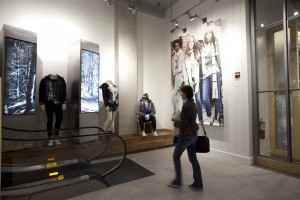Retailer picks Prysm displays for their eco-friendly visual punch


Prysm's product is the Laser Phosphor Display (LPD), which comes as 25-inch diagonal building blocks that are stacked to create the overall signage. The technology uses lasers to deliver video that is viewable from nearly a 180-degree angle, but it uses 75 percent less power than other backlit or project technologies. AEO is using seven, 7-foot tall digital signal displays arranged throughout its new 24,000-square-foot story in the SoHo district. The video discusses some of the whys and wherefores:
Prysm's vice president of sales, Dana Corey, says the main reason AEO chose its technology was that the displays offered a lot of visual punch, without significant raising the temperature of the store, which would create a vicious cycle in terms of power used for cooling purposes. According to Corey, digital signage can sometimes create a 10 percent to 15 percent increase in room temperature. "Green for them was a reduction in infrastructure impact," Corey says.
Another consideration was the fact that the Prysm displays didn't require the retailer to pull additional electricity. "Typically retailers will need to drop more power into the building, add more HVAC capacity in order to handle an installation like this," Corey adds.
Aside from retail, typical commercial applications for Prysm's technology include corporate lobbies, visualization rooms, hospitality settings or casinos. The company manufactures its products at a facility in Concord,Mass., although they are sent to the Asia-Pacific region for final assembly.